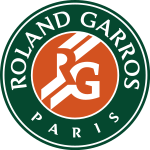
Back Franse Ope Afrikaans دورة رولان غاروس الدولية Arabic بطولة فرنسا المفتوحه ARZ Tornéu de Roland Garros AST Адкрыты чэмпіянат Францыі па тэнісе Byelorussian Адкрыты чэмпіянат Францыі па тэнісе BE-X-OLD Открито първенство на Франция Bulgarian ফ্রেঞ্চ ওপেন Bengali/Bangla Roland Garros BS Torneig de Roland Garros Catalan
 | |
| Official website | |
| Founded | 1891 |
|---|---|
| Editions | 128 (2024) 94 Grand Slam events (since 1925) |
| Location | Paris, XVIth arrondissement France |
| Venue | Stade Roland Garros (since 1928) Societé de Sport de Île de Puteaux, at Puteaux (1891–1894); Tennis Club de Paris, at Auteuil (1895–1908); Société Athlétique de la Villa Primrose at Bordeaux (1909); Croix-Catelan de Racing Club de France at the Bois de Boulogne (1910–1924, 1926); Stade Français at Saint-Cloud (1925, 1927) |
| Surface | Clay – outdoors[a] (1908–present) Sand – outdoors (1892–1907) Grass – outdoors (1891) |
| Prize money | €53,500,000 (2024) |
| Men's | |
| Draw | S (128Q) / 64D (16Q)[b] |
| Current champions | Carlos Alcaraz (singles) Marcelo Arévalo Mate Pavić (doubles) |
| Most singles titles | Rafael Nadal (14) |
| Most doubles titles | Roy Emerson (6) |
| Women's | |
| Draw | S (128Q) / 64D (16Q) |
| Current champions | Iga Świątek (singles) Coco Gauff Kateřina Siniaková (doubles) |
| Most singles titles | Chris Evert (7) |
| Most doubles titles | Martina Navratilova (7) |
| Mixed doubles | |
| Draw | 32 |
| Current champions | Laura Siegemund Édouard Roger-Vasselin |
| Most titles (male) | Ken Fletcher / Jean-Claude Barclay (3) |
| Most titles (female) | Margaret Court (4) |
| Grand Slam | |
| Last completed | |
| 2024 French Open | |
The French Open (French: Internationaux de France de tennis), also known as Roland-Garros (French: [ʁɔlɑ̃ ɡaʁos]), is a tennis tournament organized by the French Tennis Federation annually at Stade Roland Garros in Paris, France. It is chronologically the second of the four Grand Slam tennis events every year, held after the Australian Open and before Wimbledon and the US Open.
The French Open begins in late May and continues for two weeks.[c] The tournament and venue are named after the French aviator Roland Garros.[1]
The French Open is the premier clay court championship in the world and the only Grand Slam tournament currently held on this surface. Until 1975, the French Open was the only major tournament not played on grass. Between the seven rounds needed for a championship, the clay surface characteristics (slower pace, higher bounce), and the best-of-five-set men's singles matches, the French Open is widely regarded as the most physically demanding tournament in tennis.[2][3][4][5][6][7]
Cite error: There are <ref group=lower-alpha> tags or {{efn}} templates on this page, but the references will not show without a {{reflist|group=lower-alpha}} template or {{notelist}} template (see the help page).
- ^ Gershkovich, Evan (10 June 2017). "Who Was Roland Garros? The Fighter Pilot Behind the French Open". The New York Times. Archived from the original on 9 January 2022. Retrieved 25 January 2022.
- ^ Grohmann, Karolos (12 June 2023). "French Open toughest to win, making Paris record more special, Djokovic says". Reuters. Retrieved 25 April 2024.
- ^ Natekar, Gaurav (24 May 2021). "French Open 2021: Why Roland Garros is the toughest Grand Slam to win?". First Post. Archived from the original on 25 January 2022. Retrieved 25 January 2022.
- ^ Clarke, Liz (15 May 2020). "The French Open, 'unique in all the world', demands a dancer's agility and an iron will". The Washington Post. Archived from the original on 1 February 2022. Retrieved 25 January 2022.
- ^ Shine, Ossian (25 May 2017). "Roland Garros now toughest slam of all, says former champ". Reuters. Archived from the original on 25 January 2022. Retrieved 25 January 2022.
- ^ Dietz, David (12 May 2011). "French Open: Why Winning at Roland Garros Is the Pinnacle of Sports". Bleacher Report. Archived from the original on 25 January 2022. Retrieved 25 January 2022.
- ^ Clarey, Christopher (26 May 2006). "In a year of change at Roland Garros, the winners may stay the same". International Herald Tribune. Archived from the original on 16 October 2007. Retrieved 8 August 2007.